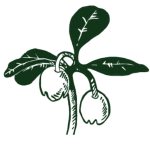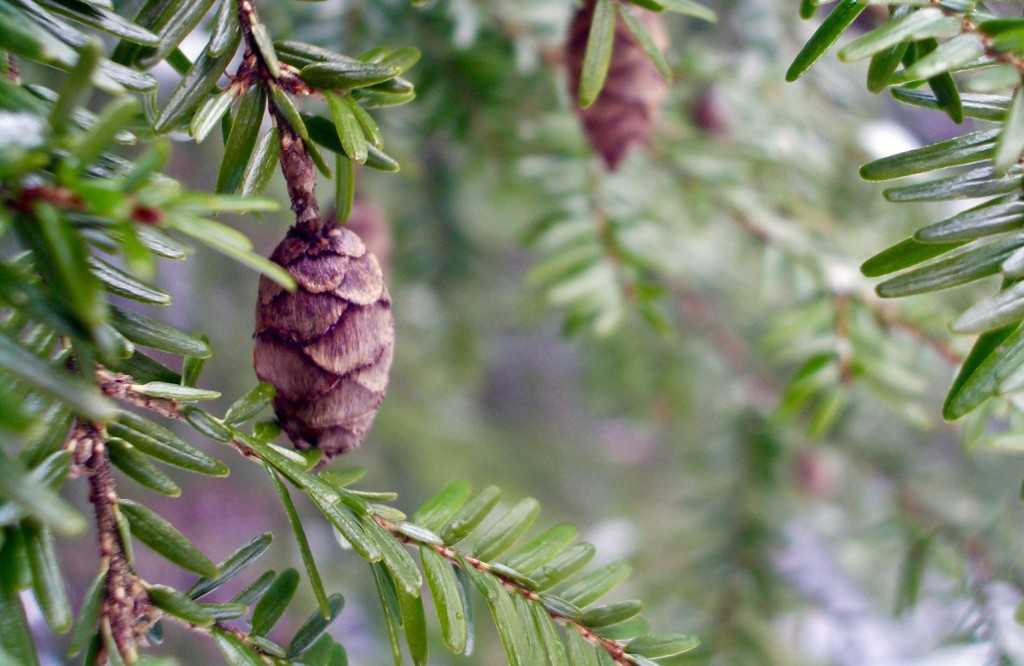Meet the Plants
It’s easy to fall in love with store-bought herbs. They’re so easy, and often they are good quality. However, it is important not to forget the many healing herbs that grow wild in our very own backyards. These plants are there for us to appreciate and call on in times of need.
Wild Medicinals of Winter
The Evergreens
In Winter, we rarely harvest herbs. However, our gracious evergreens are available to give us medicine as we need them. Most of our common evergreens have medicinal properties. (Please note that while many evergreens are healing – and several are edible – not all are safe to consume. Be particularly cautious with landscape/cultivated evergreens. Yew is a good example of a potentially toxic evergreen.)
Featured Herbs
White Pine • Hemlock • Balsam Fir • Thuja • Juniper
Also On This Page
Harvesting 101 • Attend a Plant Walk • Wildcrafting Tips
Quick Key: Local Evergreen ID Tips:
(This is just to get you started. Don’t identify on these guides alone!)
Long needles in bundles – Pines
• Bundles of 5 needles, long cones – White Pine – common
• Bundles of 3 needles, short cones – Pitch Pine
• Bundles of 2 needles, short cones – Many other Pines including Red, Jack…
Short, prickly needles, square cross section, cones point down – Spruces
• Small cones – Black, Red & White Spruce (white smells like cat piss)
(semi-common, often near water or in dense stands)
• Long cones, cultivated – Norway Spruce
Flat needles, mostly flat sprays, cones point up – Firs
• Pitch “blisters” on trunk, strong sweet scent, smooth-looking cones – Balsam Fir
(grows wild/common up north, primary Christmas tree sold already cut)
• Cones not smooth (bracts visible between cone scales), milder scent – Fraser Fir
(often cultivated for cut-your-own Christmas tree farms)
Flat needles, mostly flat sprays, small cones point down – Eastern Hemlock
common (no relation to “poison hemlock” and “water hemlock”
not poisonous) (often near water or in tall stands with nothing growing underneath, no underbrush)
Flat “scales” instead of needles
• Small, slim cones, slightly thicker scales – THUJA (aka “Northern White Cedar,” Arborvitae)
(grows wild/common up north, common in cultivation as ‘arborvitae”)
• Short, round cones, slightly thinner scales – ATLANTIC WHITE CEDAR (Chamaecyparis)
(not common, but there is a stand at the “Cedar Swamp” in Manchester)
• Blue “berries” (actually a modified cone) – JUNIPER (certain species, aka “Red Cedar”)
Short, very prickly needles, shrubby tree, round blue “berries – JUNIPER (certain species)
Flat needles, mostly flat, red berry-like fruits – YEW (poisonous! usually cultivated)
Deciduous “evergreen,” short needles in groups, small cones – LARCH
- Please see “Wildcrafting Tips,” below, before going out to harvest these plants. •
Here are just a few of the amazing plants on display in your neighborhood right now…
White Pine
(Pinus strobus) & the Pines
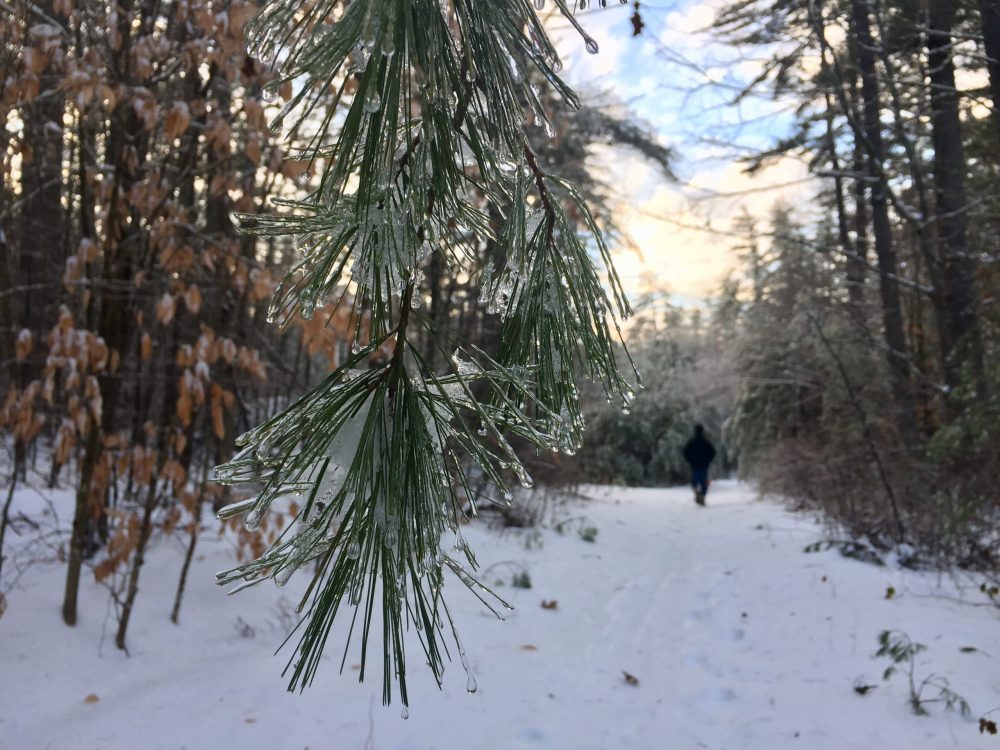
Natural History: White pine is our predominant pine and evergreen in Central/Southern New Hampshire, in part because it is well adapted to (and amplifies) our acidic soil. It has long horsetail-like needles that grow on the branches in bundles of five. Its species name “strobes” is an ancient name for an incense-bearing tree, most likely for the aromatic resin that exudes out of injuries to protect the tree. Straight white pines are important for lumber and exceptional pines were once marked as “King’s Pines” for British Navy floorboards. On younger trees, each whorl of branches signifies one year of growth. Turpentine, a paint thinner, solvent, and old-timer (toxic) remedy is made from pine. Yellow pine pollen can be found everywhere in spring. Rake up last year’s fallen pine needles for use as organic mulch in the garden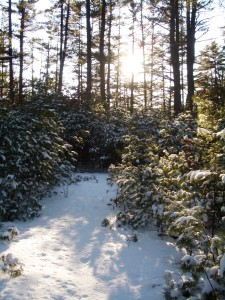 —according to local organic and native plant landscaper Ayn Whytemare, pine needles are among our best and most economical mulch sources. They’re abundant, effective, less apt to harbor slugs or contain weed seeds compared to straw and hay. Contrary to popular opinion, pine needles to not acidify the soil. Pine roots do. Pine branches make an attractive decoration during the winter months, bound together with wire as a wreath or spray. Medicinal Activity of the Needles: Young bright green needles are a good source of vitamins C and A, and they make a tasty infused tea for camping trips and bonfires. The needle tea has value for lung congestion. The needles are slightly antiseptic but also quite astringent from the tannins. These tannins are also useful for diarrhea and any weepy membrane condition. The tea has a mild diuretic and expectorant action as well. Needles can be harvested year-round but the best needles are the bright new growth in late spring. To make a tea steep a handful of pine needles in 1 pint of near-boiling water, covered, for 15 to 30 minutes, strain and drink. Young pine needle growth can be collected, chopped roughly, and simmered in honey to make an aromatic cough syrup. (See directions in Balsam Fir, below.) Medicinal Activity of the Pitch & Essential Oil: Warmed pine resin can be placed on a splinter, boil, sore, or insect bite to help draw out the irritant. It increases circulation locally (which may cause a productive throbbing) and acts as an antiseptic. Soaked into a warm cloth, it can be placed on sore joints and muscles to relieve pain, or to the chest for pneumonia. A few drops of essential oil added to a bath or inhaled as a steam is similarly useful and convenient. Collect the resin from freshly broken twigs and limbs and store in a glass container that can be gently warmed once the resin has formed a thick, sticky, dry blob. This resin can also be placed on smoldering charcoal for incense. The fresh woodsy smoke is believed to clear negative energy from an area. Similar species: Our other common pine is Red Pine (Pinus resinosa), which has more compact, decorative pinecones and needles bundled in pairs. It is a common tree for reforestation and so was abundant around Bear Brook State Park (but it was mostly logged out due to a lethal red pine scale infestation). Pitch pine (P. rigidita) and Jack pine (P. banksiana) are somewhat common in the wild in New Hampshire as well. You can see and key out other wild New England pine species here. Many more pine species are found across the United States and globe. The Pinus genus is vast and shares similar properties, but check with your bioregional herbalists (for example, Michael Moore’s writings for the southwest and west coast), historical texts (such as King’s Dispensatory and others on Henriette Kress’s site, Maud Grieve’s Modern Herbal), and local ethnobotanical history to confirm safety and efficacy of your local species. Cautions: Although pine contains similar aromatics and healing properties as the other aromatic evergreens (fir, hemlock, spruce), it is more irritating to the kidneys and digestive system, making it less useful, says Michael Moore. Turn to the other trees if you are using the remedies regularly or have any kind of kidney inflammation.
—according to local organic and native plant landscaper Ayn Whytemare, pine needles are among our best and most economical mulch sources. They’re abundant, effective, less apt to harbor slugs or contain weed seeds compared to straw and hay. Contrary to popular opinion, pine needles to not acidify the soil. Pine roots do. Pine branches make an attractive decoration during the winter months, bound together with wire as a wreath or spray. Medicinal Activity of the Needles: Young bright green needles are a good source of vitamins C and A, and they make a tasty infused tea for camping trips and bonfires. The needle tea has value for lung congestion. The needles are slightly antiseptic but also quite astringent from the tannins. These tannins are also useful for diarrhea and any weepy membrane condition. The tea has a mild diuretic and expectorant action as well. Needles can be harvested year-round but the best needles are the bright new growth in late spring. To make a tea steep a handful of pine needles in 1 pint of near-boiling water, covered, for 15 to 30 minutes, strain and drink. Young pine needle growth can be collected, chopped roughly, and simmered in honey to make an aromatic cough syrup. (See directions in Balsam Fir, below.) Medicinal Activity of the Pitch & Essential Oil: Warmed pine resin can be placed on a splinter, boil, sore, or insect bite to help draw out the irritant. It increases circulation locally (which may cause a productive throbbing) and acts as an antiseptic. Soaked into a warm cloth, it can be placed on sore joints and muscles to relieve pain, or to the chest for pneumonia. A few drops of essential oil added to a bath or inhaled as a steam is similarly useful and convenient. Collect the resin from freshly broken twigs and limbs and store in a glass container that can be gently warmed once the resin has formed a thick, sticky, dry blob. This resin can also be placed on smoldering charcoal for incense. The fresh woodsy smoke is believed to clear negative energy from an area. Similar species: Our other common pine is Red Pine (Pinus resinosa), which has more compact, decorative pinecones and needles bundled in pairs. It is a common tree for reforestation and so was abundant around Bear Brook State Park (but it was mostly logged out due to a lethal red pine scale infestation). Pitch pine (P. rigidita) and Jack pine (P. banksiana) are somewhat common in the wild in New Hampshire as well. You can see and key out other wild New England pine species here. Many more pine species are found across the United States and globe. The Pinus genus is vast and shares similar properties, but check with your bioregional herbalists (for example, Michael Moore’s writings for the southwest and west coast), historical texts (such as King’s Dispensatory and others on Henriette Kress’s site, Maud Grieve’s Modern Herbal), and local ethnobotanical history to confirm safety and efficacy of your local species. Cautions: Although pine contains similar aromatics and healing properties as the other aromatic evergreens (fir, hemlock, spruce), it is more irritating to the kidneys and digestive system, making it less useful, says Michael Moore. Turn to the other trees if you are using the remedies regularly or have any kind of kidney inflammation.
Learn more about pine medicine from Juliet Blankespoor of the Chestnut School of Herbalism and
Jade Alicandro-Mace of Milk & Honey Herbs
Learn more about working with resin, especially from evergreens, from Kiva Rose.
and also this Resin & Gum blog post by Mountain Rose Herbs
Hemlock
(Tsuga canadensis)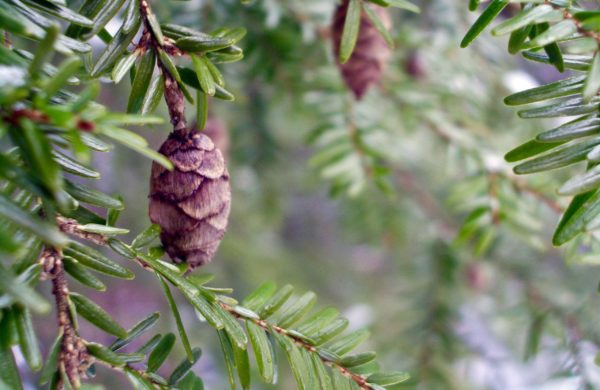
Hemlock groves are my favorite place to visit in winter. They tend to grow in wet areas near swamps, creeks, and streams in groups. They release chemicals (in shed needles) and create a thick layer of shade that inhibit the growth of other plants, which makes it easy to walk under them during warmer months. Yet, the darkness created by a hemlock grove in summer has always been spooky to me, particularly at dusk. If you stand in some hemlock groves and listen, you can hear water gently running and bubbling under a thin earthen mat created by their root systems. In winter, however, the eerie darkness of a hemlock grove is replaced by the bright white of snow clinging to its branches, creating a winter wonderland. Because the snow sticks so readily to the flat needled branches of the hemlock tree, the snow under a hemlock can be much less deep than the surrounding area. It’s a joy to stand enclosed in the snow-encrusted branches and admire their beauty. If the snow is fresh, you can examine it closely on the branch to see the shapes of the snow crystals. I like to nibble a few needles on the end of a hemlock branch; it tastes pleasantly like a Christmas tree, slightly sweet, and is a moderate source of vitamin C. In the winter, no walk in the woods is complete without a nibble on some hemlock needles, which helps me feel more connected with the forest. (If there’s no snow, I also like to eat a young leaf of a wintergreen plant.) Along with pine, hemlock is our most common wild evergreen in this area. Grouse, rabbits, deer, red squirrels, and porcupines all enjoy the food and shelter provided within a hemlock grove—so keep an eye out for them when traveling through one. The tannins in hemlock bark was once used by the tanning industry. Native Americans have been known to pound the inner bark into a flour or thickener. The tea, as with it’s comrades mentioned above, is pleasant-tasting and contains some vitamin C. The trees can grow quite tall and old. However, height is not a good determinant of age since a hemlock may stay stunted for many years in the shade of larger trees. The oldest recorded hemlock tree was 988! Hemlock groves are relatively impermeable except by humans, disease, fire, or pests. Right now the hemlock wooly adelgid threatens to destroy our local hemlock groves—a white, cobwebby substance on the branches indicates its presence. Medicinal Actions: The hemlock’s medicinal uses of the needles, bark, branches and essential oil are essentially the same as for Balsam Fir, below. The pitch/resin would presumably be used the same, but I don’t find it as prolific. Interestingly, when you buy “spruce” essential oil from Mountain Rose Herbs, if you look at the Latin name, you’ll see that it’s actually hemlock essential oil (not a very good selling name, though!). The two plants are nearly interchangeable, and around here I actually prefer hemlock’s flavor and properties to our local firs. Cautions: The same as for Balsam Fir, below. Please note that hemlock tree is completely unrelated to the parsley-family plants poison and water hemlock. It is coincidence that it has the same name. Poison and water hemlocks are deadly poisonous. Hemlock tree is not. Ecological Concerns: Hemlock trees are increasingly facing threats from the deadly (to the trees) hemlock woolly adelgid and elongate hemlock scale. I do not recommend commercial-scale harvesting of hemlock for this reason. However, it’s otherwise an abundant tree in our area that the everyday person could identify and harvest modest amounts for personal use without issue.
Check out my herb walk video on Hemlock Tree here ~
Balsam Fir
(Abies balsamea) & The Firs (Abies spp)
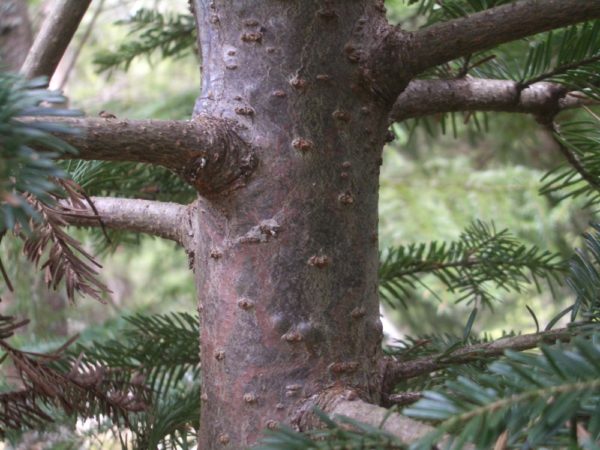
Balsam firs are not common in our woods but do grow
in the more northern areas of New Hampshire and Maine, throughout Vermont, and in western Massachusetts. They tend to grow amongst white and red spruce. Balsam fir is commonly used for Christmas trees because it is among the most pleasantly aromatic evergreens and holds its needles well once cut. Fir’s flat needles have two whitish lines on them, which spruce needles don’t have (spruce needles are also square-ish and they have drooping cones). Balsam fir bark is bulbous with pockets of pitch (resin blisters) that ooze fragrant, antiseptic resin Canada balsam if punctured. The resin has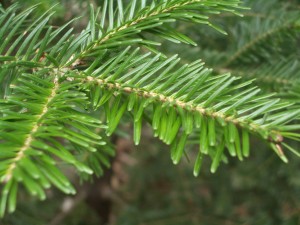 medicinal and aromatic properties and was also used as waterproof cement for mounting slides. This resin is also highly flammable. My husband’s family holds an annual tree burning post-Christmas and our dried trees go up like firecrackers thanks in part to the resin. Balsam fir, like all firs, produce upright cones, and they have flat, single needles. They drop scales rather than whole cones, leaving a spike behind on the tree. According to Michael Moore, Fir (Abies), Spruce (Picea), Hemlock (Tsuga), and Douglas-Fir (Pseudotsuga) species are medicinally interchangeable. (Pine (Pinus) can be used similarly but is harsher on the kidneys and digestive system.) Medicinal Use of the Needles: Spring and summer new growth at the tips of the branches is the best for medicine since it has stronger resinous compounds and other constituents, has gone through fewer winters, and has more soluble constituents. However, for quick use, you can harvest the needle tips
medicinal and aromatic properties and was also used as waterproof cement for mounting slides. This resin is also highly flammable. My husband’s family holds an annual tree burning post-Christmas and our dried trees go up like firecrackers thanks in part to the resin. Balsam fir, like all firs, produce upright cones, and they have flat, single needles. They drop scales rather than whole cones, leaving a spike behind on the tree. According to Michael Moore, Fir (Abies), Spruce (Picea), Hemlock (Tsuga), and Douglas-Fir (Pseudotsuga) species are medicinally interchangeable. (Pine (Pinus) can be used similarly but is harsher on the kidneys and digestive system.) Medicinal Use of the Needles: Spring and summer new growth at the tips of the branches is the best for medicine since it has stronger resinous compounds and other constituents, has gone through fewer winters, and has more soluble constituents. However, for quick use, you can harvest the needle tips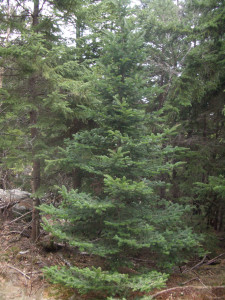 at any time. Dry or fresh needles can be infused into a wintery-tasting tea. To make a tea, infuse one handful of needles in a pint of hot water, covered, for 15-30 minutes, strain and drink. This tea is a bronchial dilator, vasodilating, expectorant, and warming. Inhale or drink to soften mild or early bronchitis. It can be used for mild lung congestion and tightness. Add a strong tea to the bath for sore joints, arthritis, and pain that comes on with barometric pressure and storms. The tea is diuretic and also contains some vitamin C. Or, warm the fresh boughs until soggy and place on sore joints. Gently simmer the needles to make a delicious honey that can be used somewhat like caught syrup. To make a honey, combine 1/2 cup of chopped needles with 2 cups of honey. Bring to a gentle boil, stirring frequently. Once it comes to a boil, shut it off and let it cool. Repeat as many times as necessary to get the flavor you want, and strain into a mason jar during the last heating. This can be taken by the spoonful, added to tea, or combined with medicinal tinctures for colds, etc. Medicinal Use of the Bark & Branches: Harvest small branches, strip the bark, and dry. Small twigs may be simply chopped and dried. To make a tea, decoct, or simmer, two tablespoons of finely chopped bark in one pint of water for 15-20 minutes, strain, and drink 1-3 ounces. The bark is rich in astringent tannins, which help to tighten membranes and are slightly antimicrobial. Drink the weak tea for long-standing diarrhea, loose stools, hemorrhoids, dysbiosis, candida flare-ups, boggy intestines, leaky gut, early Crohn’s. Topically, you can use the tea as a wash for bruises, bad knees, etc. Medicinal Use of the Pitch: If you have a lot of time and don’t mind sticky hands, you can prick the resin blisters of the balsam fir and collect the liquid that oozes out. You can apply the liquid directly to the skin to pull out foreign bodies or puss. Or, you can make a salve by melting down 1 part pitch with 5 parts oil, some alcohol, and 1 part beeswax. This drawing, warming, antimicrobial salve can also be applied to splinters, infections, sore congested joints, as a counter irritant for sprains. The pitch does not contain tannin. Medicinal Use of the Essential Oil: Essential oil of fir, spruce, hemlock, etc. can be used somewhat similarly as the pitch for rheumatic complaints, a few drops in a body oil or mixed with oil or alcohol and added to the bath. You can put a few drops in hot water and inhale for lung and sinus congestion. The uplifting fragrance can be diffused into the air for focus and mood. Place a drop on the heater, use a diffuser, or make an aromatherapy spray. For a spray, mix 1.5 ounces of water with .5 ounce of vodka and 10-20 drops of essential oil. The essential oil can also be added to cleaning products for pleasant smell, antimicrobial and grease-cutting action. I use a gentle, unscented all-purpose cleanser by Global Balance to wash my floors (or white vinegar, for wood) and like to add 10 or so drops total of fir, spruce, rosemary, and/or thyme essential oils to the bucket. It’s much healthier and better smelling than conventional cleaners. Cautions: Tannins from the bark and branches can be over-astringent and impair nutrient absorption if used in high doses (ie: a strong decoction vs. a weak) or used for too long. The tea can also be constipating if used past necessity.
at any time. Dry or fresh needles can be infused into a wintery-tasting tea. To make a tea, infuse one handful of needles in a pint of hot water, covered, for 15-30 minutes, strain and drink. This tea is a bronchial dilator, vasodilating, expectorant, and warming. Inhale or drink to soften mild or early bronchitis. It can be used for mild lung congestion and tightness. Add a strong tea to the bath for sore joints, arthritis, and pain that comes on with barometric pressure and storms. The tea is diuretic and also contains some vitamin C. Or, warm the fresh boughs until soggy and place on sore joints. Gently simmer the needles to make a delicious honey that can be used somewhat like caught syrup. To make a honey, combine 1/2 cup of chopped needles with 2 cups of honey. Bring to a gentle boil, stirring frequently. Once it comes to a boil, shut it off and let it cool. Repeat as many times as necessary to get the flavor you want, and strain into a mason jar during the last heating. This can be taken by the spoonful, added to tea, or combined with medicinal tinctures for colds, etc. Medicinal Use of the Bark & Branches: Harvest small branches, strip the bark, and dry. Small twigs may be simply chopped and dried. To make a tea, decoct, or simmer, two tablespoons of finely chopped bark in one pint of water for 15-20 minutes, strain, and drink 1-3 ounces. The bark is rich in astringent tannins, which help to tighten membranes and are slightly antimicrobial. Drink the weak tea for long-standing diarrhea, loose stools, hemorrhoids, dysbiosis, candida flare-ups, boggy intestines, leaky gut, early Crohn’s. Topically, you can use the tea as a wash for bruises, bad knees, etc. Medicinal Use of the Pitch: If you have a lot of time and don’t mind sticky hands, you can prick the resin blisters of the balsam fir and collect the liquid that oozes out. You can apply the liquid directly to the skin to pull out foreign bodies or puss. Or, you can make a salve by melting down 1 part pitch with 5 parts oil, some alcohol, and 1 part beeswax. This drawing, warming, antimicrobial salve can also be applied to splinters, infections, sore congested joints, as a counter irritant for sprains. The pitch does not contain tannin. Medicinal Use of the Essential Oil: Essential oil of fir, spruce, hemlock, etc. can be used somewhat similarly as the pitch for rheumatic complaints, a few drops in a body oil or mixed with oil or alcohol and added to the bath. You can put a few drops in hot water and inhale for lung and sinus congestion. The uplifting fragrance can be diffused into the air for focus and mood. Place a drop on the heater, use a diffuser, or make an aromatherapy spray. For a spray, mix 1.5 ounces of water with .5 ounce of vodka and 10-20 drops of essential oil. The essential oil can also be added to cleaning products for pleasant smell, antimicrobial and grease-cutting action. I use a gentle, unscented all-purpose cleanser by Global Balance to wash my floors (or white vinegar, for wood) and like to add 10 or so drops total of fir, spruce, rosemary, and/or thyme essential oils to the bucket. It’s much healthier and better smelling than conventional cleaners. Cautions: Tannins from the bark and branches can be over-astringent and impair nutrient absorption if used in high doses (ie: a strong decoction vs. a weak) or used for too long. The tea can also be constipating if used past necessity.
Thuja
a.k.a. Arborvitae and Northern White Cedar (Thuja occidentalis)
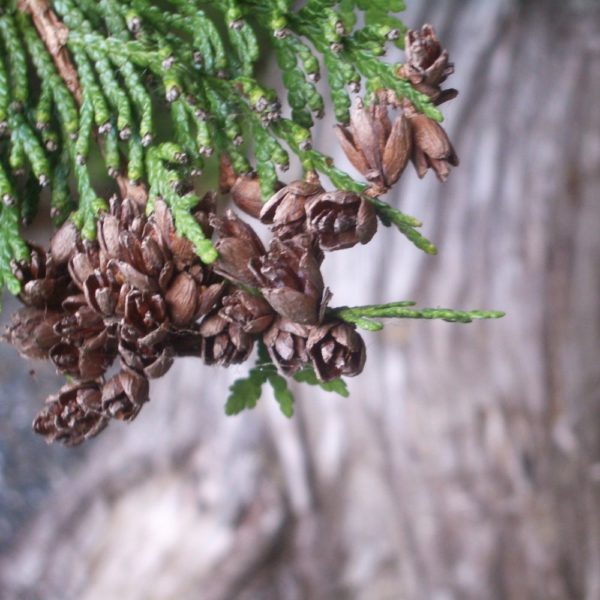 This attractive tree grows wild throughout much of Massachusetts and New Hampshire, almost all of Maine and Vermont, yet it does not generally grow in our south/central NH region. (If you look at a distribution map, we are a vacant circle surrounded by a mass of trees.) However, you may have a cultivated thuja growing in your yard. Also known as arborvitae, thuja is a popular landscaping tree for its beauty, and in rows for privacy. Our thuja can be used as incense but don’t smell quite as sweet as the western species. I like to clip a small thuja branch when I find it to see if it smells nice as incense. (So far the best one was from the side of my old apartment in Manchester, if you can believe it.) You can certainly use cultivated thuja medicinally, but watch it throughout the growing season to be sure that it IS Thuja occidentalis and also make sure it (and the surrounding area) has not been treated with any
This attractive tree grows wild throughout much of Massachusetts and New Hampshire, almost all of Maine and Vermont, yet it does not generally grow in our south/central NH region. (If you look at a distribution map, we are a vacant circle surrounded by a mass of trees.) However, you may have a cultivated thuja growing in your yard. Also known as arborvitae, thuja is a popular landscaping tree for its beauty, and in rows for privacy. Our thuja can be used as incense but don’t smell quite as sweet as the western species. I like to clip a small thuja branch when I find it to see if it smells nice as incense. (So far the best one was from the side of my old apartment in Manchester, if you can believe it.) You can certainly use cultivated thuja medicinally, but watch it throughout the growing season to be sure that it IS Thuja occidentalis and also make sure it (and the surrounding area) has not been treated with any 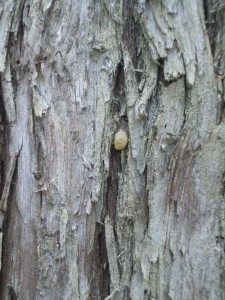 landscaping chemicals. Arborvitae, means “tree of life.” It was named this after Native Americans used thuja tea to cure the men of Cartier’s Canadian expedition of scurvy. As a result thuja was the first tree to be exported from America to Europe. (Or was it? According to botanist and forager Arthur Haines, the explorers misidentified thuja when it was actually white pine that the Native Americans used.) Thuja’s outer bark makes good tinder, and “cedar” swamps create a nice habitat for moose, deer, rabbits, squirrels, and songbirds. Although there are some similarities, thuja is used much differently than the other evergreens in medicine. Medicinal Use of the Scales: Thuja first and foremost is used as a topical antifungal and for warts. You can make a tincture of the scales by snipping them into a jar until you can’t pack any more in, then fill the jar to the brim with whole grain alcohol or vodka. Let it sit for at least one month, strain. This is best for
landscaping chemicals. Arborvitae, means “tree of life.” It was named this after Native Americans used thuja tea to cure the men of Cartier’s Canadian expedition of scurvy. As a result thuja was the first tree to be exported from America to Europe. (Or was it? According to botanist and forager Arthur Haines, the explorers misidentified thuja when it was actually white pine that the Native Americans used.) Thuja’s outer bark makes good tinder, and “cedar” swamps create a nice habitat for moose, deer, rabbits, squirrels, and songbirds. Although there are some similarities, thuja is used much differently than the other evergreens in medicine. Medicinal Use of the Scales: Thuja first and foremost is used as a topical antifungal and for warts. You can make a tincture of the scales by snipping them into a jar until you can’t pack any more in, then fill the jar to the brim with whole grain alcohol or vodka. Let it sit for at least one month, strain. This is best for 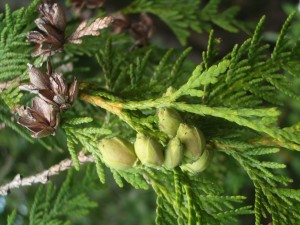 topical—not internal—use. Thuja oil can be made and used similarly. To make thuja oil, steep 1 ounce of fresh or dried thuja scales in 7 ounces of extra virgin olive oil, place the container in a warm place for 2 weeks and then strain, OR heat the mixture to 100 degrees for a day and then strain. OR, grind up the freshly dried scales with 1/2 ounce of whole grain alcohol, cover and let sit for about 1 day, then combine in a blender with 7 ounces of olive oil. Run on high for about 5 minutes, strain through cloth. Commercially-made thuja oil can be purchased or special ordered from companies like Gaia and Herb Pharm in most natural food stores. Apply the oil or tincture topically for skin fungus including tinea, barber’s itch, plumber’s fingernails and toenail fungus (use a cotton swab to get it under the nail as well). Skin fungus is hard to get rid of, so be prepared to apply the
topical—not internal—use. Thuja oil can be made and used similarly. To make thuja oil, steep 1 ounce of fresh or dried thuja scales in 7 ounces of extra virgin olive oil, place the container in a warm place for 2 weeks and then strain, OR heat the mixture to 100 degrees for a day and then strain. OR, grind up the freshly dried scales with 1/2 ounce of whole grain alcohol, cover and let sit for about 1 day, then combine in a blender with 7 ounces of olive oil. Run on high for about 5 minutes, strain through cloth. Commercially-made thuja oil can be purchased or special ordered from companies like Gaia and Herb Pharm in most natural food stores. Apply the oil or tincture topically for skin fungus including tinea, barber’s itch, plumber’s fingernails and toenail fungus (use a cotton swab to get it under the nail as well). Skin fungus is hard to get rid of, so be prepared to apply the
thuja AT LEAST twice daily (three or more times is preferable) for a month or more. The oil, and perhaps the tincture, are also applied topically, and regularly, to get rid of warts. The tincture can be used as a topical disinfectant as well. Thuja tea or tincture is sometimes used internally to stimulate the innate immune system, specifically macrophages. It is in at least one European cold and flu formula called Esperitox (distributed in the US by Enzymatic Therapy) with echinacea and baptisia. Thuja tincture is used in relatively small doses internally, 5 to 15 drops (most other tinctures are 30-60 drops) up to four times a day. Cautions: The essential oils in the scales can be irritating to the kidneys. It is not recommended for long-term use internally, unless under the guidance of a practitioner. Avoid even moderate doses internally, and avoid completely if there is any kidney weakness or disease. Use caution in autoimmune diseases like lupus and rheumatoid arthritis (the use of an immune-booster may bring on an attack). Homeopathic Use of Thuja: Natural food stores are most apt to sell thuja in homeopathic form, usually marked as “Thuja 30C” (30 C means that the remedy was diluted 30 to the 100th time). Homeopathics are incredibly dilute remedies that often contain no chemical markers of the plant itself yet it is used to simulate the body to heal itself. Homeopathic is most often used to get rid of warts, taken internally, about 5 pellets four times a day for several weeks. Take a break for a week or two, and repeat until the warts are gone. You can make your own homeopathic liquid by diluting a tincture many times. However, you’d want to consult a homeopath for specific directions. One of the primary advantages (from an herbalist’s point of view) is that homeopathics are less apt to produce side effects. As an herbalist, my view of homeopathy is probably much simpler than that of a homeopath. Similar Species: Thuja occidentalis’s scales are thicker compared to the similar, yet more delicate-looking, Atlantic White Cedar (a different genus all together, Chamaecyparis thyoides, which grows wild in the south and creates one of its most northern stands in the beautiful Cedar Swamp land in Hooksett). Thuja can look a lot like, but does not have the blue “berries” of some of the scaly species of Juniper (Juniperus virginiana, J. spp), which are sometimes also called Red Cedar. (Strangely, NONE of these plants are in the true old world cedar genus Cedrus, which doesn’t grow here.) THESE PLANTS ARE NOT USED THE SAME AS THUJA. To avoid confusion—and go more with the herbal medical texts—I prefer to call our tree “thuja” rather than “cedar”. Thuja plicata grows on the other end of the continent in the Pacific Northwest and is sometimes called Incense Cedar because the dried branches can be lit and then smoldered for a delicious-smelling incense used for fragrance and spiritual reasons. T. plicata has similar medicinal uses as T. occidentalis; however, ours is most often used medicinally, and theirs is most often used for incense. (Note: Thuja pitch makes a lovely incense reminiscent of copal.)
Juniper
(Juniperus communis and other species)
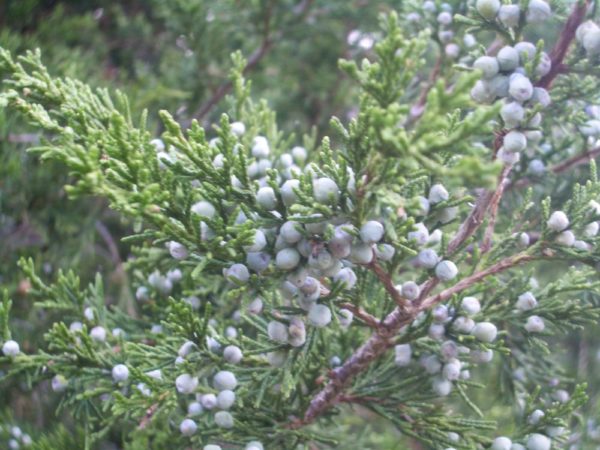 There are many species of juniper, and some can look quite different, although all of them generally have blue “berries.” From the huge juniper trees of the west and scaly trees (sometimes called red “cedar”) that look much like thuja, to the prickly, needle-y creeping bushes, the trees can seem unrelated. Our primary medicinal juniper is common juniper, the later description, with other species sometimes, not always, being used interchangeably. Juniper berries can be harvested when ripe for culinary and medicinal use—they have a piney, resinous flavor reminiscent of gin (which is flavored with, you guessed it, juniper berries, as well as other herbs). Needles and branches can be collected at any time. Native
There are many species of juniper, and some can look quite different, although all of them generally have blue “berries.” From the huge juniper trees of the west and scaly trees (sometimes called red “cedar”) that look much like thuja, to the prickly, needle-y creeping bushes, the trees can seem unrelated. Our primary medicinal juniper is common juniper, the later description, with other species sometimes, not always, being used interchangeably. Juniper berries can be harvested when ripe for culinary and medicinal use—they have a piney, resinous flavor reminiscent of gin (which is flavored with, you guessed it, juniper berries, as well as other herbs). Needles and branches can be collected at any time. Native 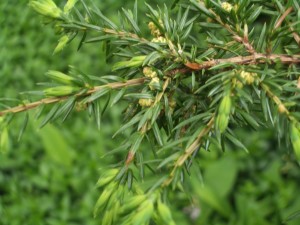 Americans use all aromatic parts of the plant to clear “bad vibes” and protect against black magic. The plant is often used as incense. Desert juniper species are burnt into an ash and then, from the ash, flat cakes are made which are incredibly high in minerals including calcium. Medicinal Use of Juniper: Needles and berries are used similarly in tea or tincture form for the urinary tract. The berries are slightly more disinfectant, the needles more astringent. Juniper is among our best urinary disinfectants (as are heath family members uva ursi, trailing arbutus and, to a lesser extent, blueberry leaves) for UTIs and cystitis. It is diuretic, astringent, antimicrobial, and somewhat pain-relieving. It’s best combined with soothing plants like slippery elm, cornsilk, and/or marshmallow as well as more gentle urinary herbs like blueberry leaf, trailing arbutus, and pipsissewa. Follow the same basic tincture recipe as listed in Thuja, above. Follow the same basic recipe for tea as mentioned in Balsam Fir, above. If you’re using berries, use slightly less volume of berries since they’re more dense. Juniper berries are used in food, especially poultry and wild game. Michael Moore recommends 10 berries per pound of meat. And if you chew a juniper berry before your meal, it will stimulate digestion. Juniper essential oils is often used to stimulate circulation, detoxify, and relieve pain in the body. A few drops can be added to vegetable oil or alcohol and then added to the bath. For circulation and detoxification, you can add a few drops to a body scrub. Make your own body scrub by mixing 1 cup of salt (sea or Epsom) with 1/2 cup of vegetable oil and 10-20 drops of essential oil. Cautions: Juniper is best short-term since the essential oils in the plant are irritating to the kidneys. For this same reason, juniper is contraindicated in a urinary problem that has moved north into the kidneys, with flanking pain in the lower back. Juniper is not recommended if you’re pregnant (too stimulating to the uterus) or have a kidney disease.
Americans use all aromatic parts of the plant to clear “bad vibes” and protect against black magic. The plant is often used as incense. Desert juniper species are burnt into an ash and then, from the ash, flat cakes are made which are incredibly high in minerals including calcium. Medicinal Use of Juniper: Needles and berries are used similarly in tea or tincture form for the urinary tract. The berries are slightly more disinfectant, the needles more astringent. Juniper is among our best urinary disinfectants (as are heath family members uva ursi, trailing arbutus and, to a lesser extent, blueberry leaves) for UTIs and cystitis. It is diuretic, astringent, antimicrobial, and somewhat pain-relieving. It’s best combined with soothing plants like slippery elm, cornsilk, and/or marshmallow as well as more gentle urinary herbs like blueberry leaf, trailing arbutus, and pipsissewa. Follow the same basic tincture recipe as listed in Thuja, above. Follow the same basic recipe for tea as mentioned in Balsam Fir, above. If you’re using berries, use slightly less volume of berries since they’re more dense. Juniper berries are used in food, especially poultry and wild game. Michael Moore recommends 10 berries per pound of meat. And if you chew a juniper berry before your meal, it will stimulate digestion. Juniper essential oils is often used to stimulate circulation, detoxify, and relieve pain in the body. A few drops can be added to vegetable oil or alcohol and then added to the bath. For circulation and detoxification, you can add a few drops to a body scrub. Make your own body scrub by mixing 1 cup of salt (sea or Epsom) with 1/2 cup of vegetable oil and 10-20 drops of essential oil. Cautions: Juniper is best short-term since the essential oils in the plant are irritating to the kidneys. For this same reason, juniper is contraindicated in a urinary problem that has moved north into the kidneys, with flanking pain in the lower back. Juniper is not recommended if you’re pregnant (too stimulating to the uterus) or have a kidney disease.
Harvesting 101
It takes some practice, but harvesting your own herbs for medicine is an enjoyable, rewarding, and often simple experience.
Click here for Maria’s basic tips for harvesting and processing roots, barks, leaves, flowers, and berries from wild and cultivated medicinal plants.
Attend a Plant Walk
One of the best ways to learn how to identify and use medicinal plants is to attend plant walks.
Area Plant Walks
Search around, and you’ll find them! Check out…
- My Education page for upcoming herb walks
- NH Herbal Network meetings, workshops, herb days, and events
- Local Audubon centers
- D Acres in Dorchester
- Misty Meadows in Lee
- Lion’s Tooth Herbals in Newmarket
- Historical gardens like Canterbury Shaker Village, Strawbery Banke, Kirkwood Gardens , Tarbin Gardens, The Fells, and Enfield Shaker Museum in New Hampshire
- New England Wildflower Society’s Garden in the Woods, Tower Hill, and the Arnold Arboretum, and Mass Hort in Massachusetts
- Avena Botanicals and Coastal Maine Botanical Gardens in midcoast Maine
- Schedule a private consult/walk with Maria – email office@wintergreenbotanicals.com
Keep looking around, you’ll find them!
Note: unless the walk is led by an herbalist, it will probably not cover the medicinal uses of plants, but it should still offer useful information about how to identify the plants.
Wildcrafting Tips
Click here to download Wildcrafting 101
Safety & Identification
• Always make sure you have correctly identified the plant you are harvesting. Cross reference ID books (see recommendations, below), information from herb walks, etc. You’ll have the best luck identifying a plant with ID/field guides, and then learning how to use it from herbals or foraging books. Don’t try to get *all* your information from just one book. It *will* be lacking.
• I like to watch a plant for at least one full year to make sure I am comfortable with its identification. Look at leaves, flowers, seedpods, fruits, growing patterns. If something you see doesn’t quite match with the identification patterns put forth in a book, don’t pick it. Wait and keep researching.
• Most plants are easiest to identify when they are in flower, even if this isn’t the primary harvesting time. Keep an eye out for flowers to find the plant, get to know it (this may take a year or so – no rush), and then go back when it is time to harvest.
• Try to ensure that you are picking from a clean area. Keep away from roads and nearby highways. Make sure the land does not get sprayed with chemicals. If picking by waterways, ensure that the water is clean. Many plants are known to concentrate chemicals in the ground or water.
• Don’t be afraid to “borrow” someone’s land (with permission). Most of my wildcrafting is done on the land of organic or semi-organic farms. If you know a family that has lived on the same untouched land for 50 years, then ask them if you can walk around to identify and pick weeds or pay/trade for cultivated plants.
• Avoid sickly plants that seem to have diseases or bug infestations. If it doesn’t look “happy,” don’t harvest it.
Plant Ethics
• Never harvest a plant unless it is abundant in that area. • Never harvest more than 1-10% of the plants.
• Be a good land steward. Return to a stand frequently, at the very least annually, to ensure that your harvesting is not harming the plant population.
• When possible, harvest in a manner that promotes the growth of a plant. For instance, pinching off mint-like plants, carefully pruning small branches of trees for bark. Make sure to leave some flowers to go to seed, fruits for wildlife, etc.
• Consider an act of gratitude and repayment for your harvest: help the plant sew more seeds, pick up trash, neaten the trails. On a grander scale, work to conserve land in your community and the world.
• Leave the land looking untouched. If you dig a root, mulch the above ground parts and fill in the hole. No matter what you pick, it should be unnoticeable (or barely noticeable) that you were there.
• Harvest only what you need. • Harvest small or sensitive plants sparingly, or not at all. (Ex: lobelia, bugleweed, partridgeberry, goldthread) Be particularly cautious with wild, native, perennial roots. (Ex: Trillium, goldenseal, ginseng.)
• Opt to harvest weedy and invasive plants rather than native and sensitive ones. You can generally harvest as much dandelion, burdock, autumn olive, plantain, Japanese knotweed, etc. as you like!
• Refer to lists made by United Plant Savers and other groups to ensure that you are not picking a plant that is at risk of being endangered. www.unitedplantsavers.org
• Step lightly when going off-trail to harvest plants.
People Ethics
• Get permission to pick plants in an area that you do not own.
• If you are harvesting from someone’s land, offer to give them something in return.
• Never pick in protected lands.
• Don’t pick near trails.
Recommended Reading
• Botany in a Day, Thomas Epel – A good start to medicinal plant botany. Learn by plant families. Great illustrations, easy to understand.
• Newcomb’s Wildflower Guide – THE best ID guide for our area. The keys make it easy to find plants quickly, and the illustrations are excellent. However, always cross-reference with at least a couple ID guides. There are many & all have advantages/disadvantages.
• Trees and Shrubs of New England; Spring Wildflowers of New England; Summer & Fall Wildflowers of New England, all by Marilyn J. Dwelley – Dwelley’s books are specific to our region and have interesting information about the plants that most guides don’t share. Unfortunately some illustrations are poor. Generally organized by flower color, and within flower color by plant family.
• Peterson Field Guide: Wildflowers, Peterson & McKenny – Organized by flower color & relatively expansive. A good second book when Newcomb’s fails to ID your plant.
• Another great thing you can do to confirm ID of a plant is to do a Google Image search. Go to www.google.com, and click on “Images.” Then search for common or Latin names & compare the photos to your plant. Not everything on the web is accurate, but it’s a great link to millions of plant photos.
To get to know the plants in your area, walk the same spots at least once a week and see how the plants and landscape change. Try to ID every flowering plant you see.
• Go to botanical gardens now and then to see a variety of plants already identified for you. Locally, we have Strawbery Banke (herbs) in Portsmouth, NH; Garden in the Woods (wildflowers) in Framingham, MA; and the Arnold Arboretum (trees) in Jamaica Plain/Boston, MA.
• Attend a plant walk. Many herbalists host herb walks and events on their properties. Several of our local Audubon centers offer plant walks led by herbalists.
